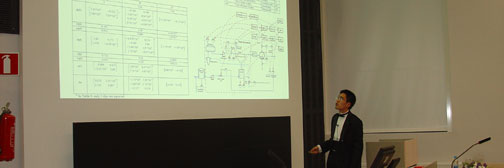| | Year 2006
Tea TuuliDynamic Phenomena in a Continuous Digester
The modelling and simulation of cooking processes in continuous digesters has been researched for decades. Modelling has enabled the analysis of the behaviour of different raw materials in the digesters. Dynamic behaviour such as fluctuation causes changes in pulp quality, and in pulp uniformity in particular. The huge sizes of modern continuous digesters have clearly highlighted this. In addition to causing quality variations, the process dynamics and fluctuation make demands on the digester control system and on the operation of the rest of the fiberline. Their occurrence, scale and causes must accordingly be known.
The objective of this thesis is to investigate the applicability of certain multivariate methods for analysing the process data of Oy Metsä-Botnia AB’s Joutseno Mill as well as discovery and recognition of dynamic phenomena occurring in the process. In practice, this means the identification of fluctuation in the cooking area and recognition of its causes and effects. The second objective is to analyse whether the control strategy is able to cope with the dynamic phenomena. The thesis also evaluates the suitability of KCL’s Wedge software for pulp mill process data.
The research was conducted by analysing the 10 minute data of several measurement positions in the cooking zone gathered from the mill’s information system. Before the analysis, key measurement points were selected on the basis of interviews and predata analysis. The remaining variables were first analysed by principal component analysis in order to establish the general behaviour of the process. Afterwards, a few important variables were selected and their behaviour was studied using multivariate autoregressive analysis. For each variable, the blow line kappa number and chip silo level were analysed using the partial least squares method. The temperature profile of the digester zone was also examined using self-organized maps.
The results show that there is indeed fluctuation in the cooking zone. Control strategies for different pulp grades cause some of the fluctuation, but each pulp grade behaves differently in the cooking area. The most significant variable sources turned out to be liquor circulations and control of the chip bed in the digester. Liquor changes are due to externally initiated parameter changes. The chip bed related control loops of the chip level, blow flow and washing of one pulp grade were more prone to fluctuate in the digester. No regular fluctuation in specific variables was found, except for the chip silo level. This indicates that the digester should be studied state-specifically. Fluctuation in the cooking area’s quality variable, the kappa number, was not caused by any individual variable. Analysis of the temperature profile revealed indications of channelling and packaging degree changes in the digester.
Deprecated: strlen(): Passing null to parameter #1 ($string) of type string is deprecated in C:\WWWroot\Root\incs\5_theses\theses_new2010.php on line 248
This info last modified 27 Apr 2024 by Jerri Kämpe-Hellenius
|

